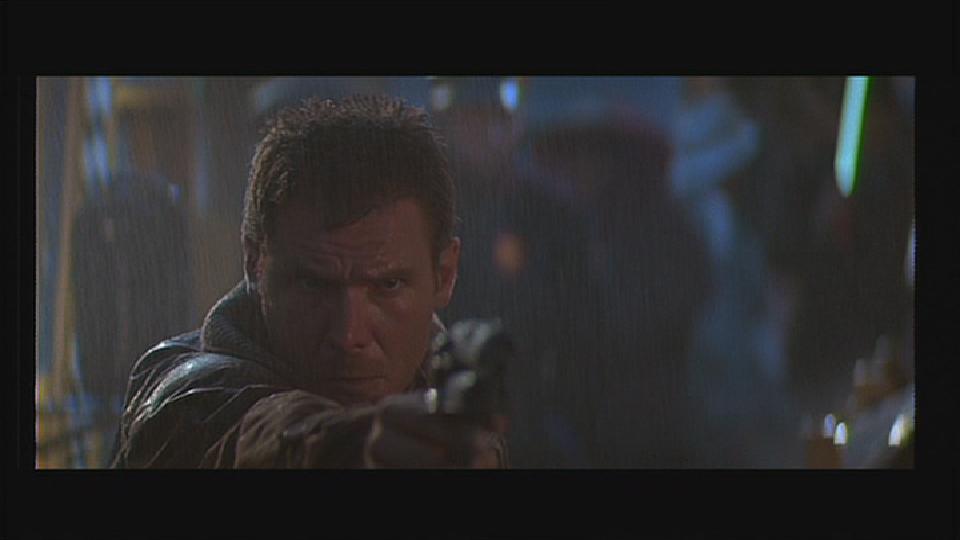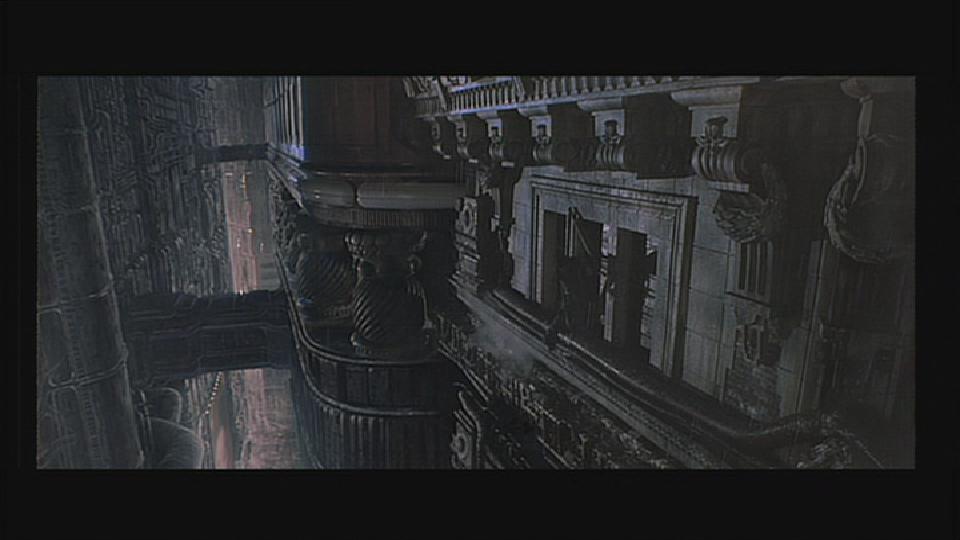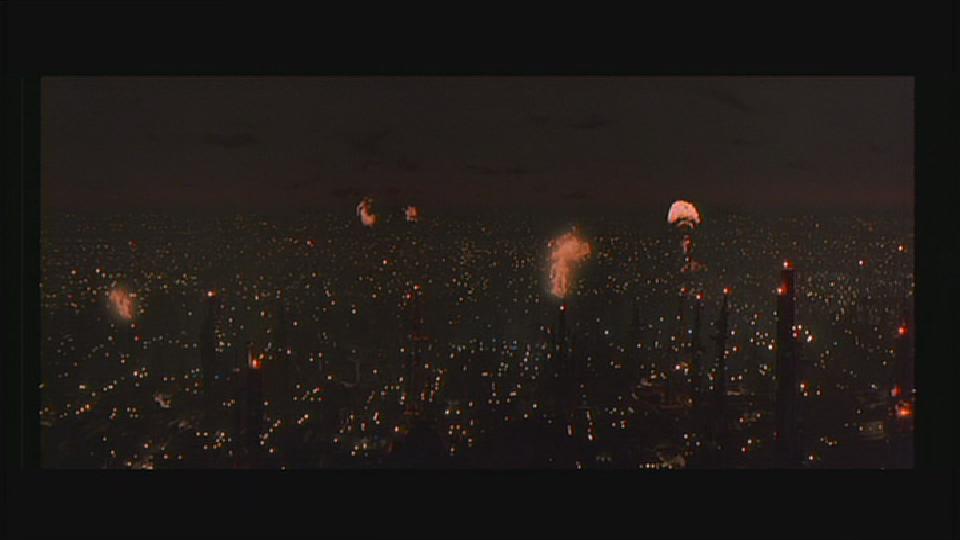
Harrison Ford as Rick Deckard. Rutger Hauer as Roy Batty (below). 
By Ray Schwetz
Blade Runner: The Director's Cut
Warner Home Video.
The year is 2019 AD. The sun doesn't shine on the overcrowded, neon-lit streets of Los Angeles. It's blocked out by towering buildings, video billboards, and constant rain. Eldon Tyrell, one of the few wealthy people who has not left earth for a more promising "off world colony," is head of a corporation that creates artificial beings, called replicants, to serve mankind as slaves to work in off-world mining or colonization.
These replicants have a four year lifespan and are "more human than human." Four sophisticated Nexus 6 replicants have escaped an off world mining facility in a bloody battle and shuttled to earth. The replicants; Roy Batty (Rutger Hauer), Pris (Daryl Hannah), Leon (Brion James), and Zhora (Joanna Cassidy) are desperate to find Tyrell in an effort to prolong their stunted lifespan. The replicants are capable of developing human emotions over time and therefore a potential hazard. As a result Rick Deckard (Harrison Ford), the best "blade runner" is unwillingly brought back on the force to "retire" the renegades. While in pursuit of the renegades, he developes feelings for Rachel (Sean Young), a woman who only recently discovered that she is a replicant implanted with someone else's memories.
The world of Ridley Scott's film "Blade Runner" deeply resembles Fritz Lang's "Metropolis" in its compelling, forbidding vision of the future. In most futuristic sci-fi films, like George Lucas' "THX 1138" for example, the buildings are cold, clean, barren, and architecturally perfect structures. But in "Blade Runner" the city is owercrowded and alive with activity; each resident moving forward with their own agenda. Everything is old, impersonal, and seedy. New buildings of glass an steel are constructed atop the older buildings, which serve as dilapidated bases. These buildings tower so high above LA that they make the streets seem like sewers. The people who populate these streets are literally "low lifes."
"Blade Runner" presents the viewer with objects from our own past to remind us that Deckard's world is the end result of our unfortunate progression. Photographs of Deckard's family, dated from early 20th century, are scattered about his apartment. Neon Atari, Pepsi, and TDK ads blaze throughout the city. There are even Hare Krishnas and "punk" teens strolling the streets. Keep in mind, this future society is only 19 years away, therefore it must be a tangible future.
Incidentally, this director's cut, available through Warner, omits the narration slapped on the film's theatrical release during post production by the studio. Personally, I feel that the studio made the right decision. Ford's deadpan narration offers insight into the character's motivations, details about this future world, and adds to the film's noir-ish feel. Purists may disagree, but I prefer this version. However, I will admit that the omission of the narration does allow the viewer to more fully immerse themselves into this future LA. Also, those familiar with both versions will notice the many sound effects omitted by the narration.
When we first meet Deckard he describes himself, in the narration, as a cold fish. In 2019, this term accurately describes a large percentage of the world population. Deckard himself has completely withdrawn into a wave of impersonal inhumanity.
He supresses his humanity with alcohol and heavy doses of guilt. Through his interaction with the human-like replicants, he begins to question his actions and regain his emotions. For example, upon his first meeting with Rachel he is sexually attracted to her, but otherwise he has no use for her. As Harrison Ford states," ...He's the type of guy that would see them (women) occasionally but not have any use for them around the house. He has a wife and child but they seem to have gone on in search of a better life (perhaps they're just implanted memories?)
Deckard acknowledges at Rachel's first appearance that she is attractive. But then she becomes a puzzle and, when he figures out that she is a replicant, he seems to have no further use for her. He sees Rachel as zero." Soon after, his ability to love is rekindled by Rachel. In an awkwardly erotic scene (dubbed by the crew as "the hate scene," jokingly referring to Ford and Young?bvious dislike towards each other), Deckard seduces Rachel and teaches her to love. She is confused because she doesn't have memory implants telling her how to love. Through this experience she becomes an emotional human being.
The final confrontation between Batty and Deckard is very symbolic. In one graphic scene Batty drives a nail through his hand to feel something, anything, to reassure him that he is still alive. The confrontation results in a gesture of mercy and humanity that is one of the most powerful moments I have ever seen in a science fiction film. It's a touching moment that is one of the only peaceful moments between man and machine (with the exception of the conclusion of "T2") captured in a film.
The director's cut adds a controversial scene in the film that shows Deckard dreaming of a unicorn (the image recalls Ridley Scott's next film, the Tom Cruise fantasy film flop "Legend"). This scene suggests that Deckard himself may unknowingly be a replicant. Recently, Scott has gone on record stating that Deckard is indeed a replicant. He says that at the film's end, Deckard realizes this when he picks up Gaff's origami message.
Many fans of "Blade Runner" were quite upset that Scott revealed this. They say that it ruins the mystery. However, it doesn't matter whether he is or is not a replicant, because his humanity is reborn by the end of the film and he is now worthy of carrying humanity's torch. He, like us, does not know when his life span is up. He just wants to make the most of it.
Interestingly, Gaff's origami unicorn has been interpreted by some fans as a message to Deckard that they both shared the same dream. Therefore, they are all replicants.
Blade Runner is a film that improves with each viewing. In the excellent BBC documentary "On the Edge of Blade Runner," Scott states that viewers keep returning to this film as they would to a favorite book. Upon first look, the awesome visuals (courtesy of special effect wiz Douglas Trumball and brainchild of artist Syd Mead) overpower the story. After I became accustomed to the visual effects, I realized that the best moments of the film were emotional, human moments.
The performances are first rate. Sean Young is heartbreaking as Rachel. When she is devistated by the knowledge that she is not human, we feel devastated as well. Rutger Hauer gives the performance of his career as Batty. Harrison Ford makes a perfectly somber private eye. Known for his more lively roles as Han Solo and Indiana Jones, Ford displays a great range of emotion in his first truly complex role as Deckard.
The hauntingly beautiful score by Vangelis (only recently released on compact disc) is simply one of the most inventive film scores ever produced. Ridley Scott's direction and his attention to detail make his vision totally believable. Although the tone of the film is dark and downbeat, the conclusion is satisfying and hopeful.
For comparison puproses, I'll make mention of most existing legal release versions of "Blade Runner." The Criterion CAV double laserdisc set is a must for the serious sci-fi fan. The pan/scan Embassy tape and disc is absolutely atrocious. All of Scott's intricately detailed compositions are destroyed there. The letterboxed director's cut widely available through Warner Home Video on DVD, and is currently the best way to view the film on home video.
The image and sound quality of the DVD is light years ahead of the Criterion laserdisc and Warner's own laser of the director's cut. The image quality of the DVD is simply awesome. Ten years ago (oy!), the exceptional image of the Criterion laserdisc convinced me to buy my first videodisc player.
Seeing the Warner DVD of "Blade Runner: The Director's Cut" convinced me to buy my first DVD player. The DVD is accurately framed in a 2.35:1 aspect ratio. The film has never looked this crisp. The colors are outstanding and the black level is very good. There is no really noticeable artifacting, except in the opening credits (keep in mind this was one of the first DVD's available).
The Dolby Digital 2.0 surround sound is very satisfying, although with THX and Dolby Digital technology pushing the envelope, it doesn't hold a candle to more current releases like Warner's "Deep Blue Sea." The surround channels are alive with computer chirps, spinner engines, and street noises that immerse the viewer in the future metropolis. Bass level is equally satisfying. Dialogue sounds a bit tinny at times, but is clear as a bell. Hopefully, the upcoming Special Edition DVD will remix the sound via 5.1.
The extras on the DVD are pretty bare bones. Just your typical bios and film facts. The extras found on the Criterion laserdisc are pretty neat. There's a Syd Mead featurette and "Blade Runner" trivia questions. I'm sure that the extras on the upcoming "Blade Runner: The Director's Cut Special Edition" DVD (not to be confused with the pricey "Blade Runner: The Director's Cut" Box Set, complete with 35mm film frame, mini lobby cards, etc.) will finally give the fans what they want; proper recognition of a classic. "Blade Runner" is a benchmark in science fiction film which is my personal favorite film of all time. Warner's current DVD is great, but it merely whets the appetite for things to come. Have a better one!

One of Syd Mead's impressive retro-futuristic designs. |

